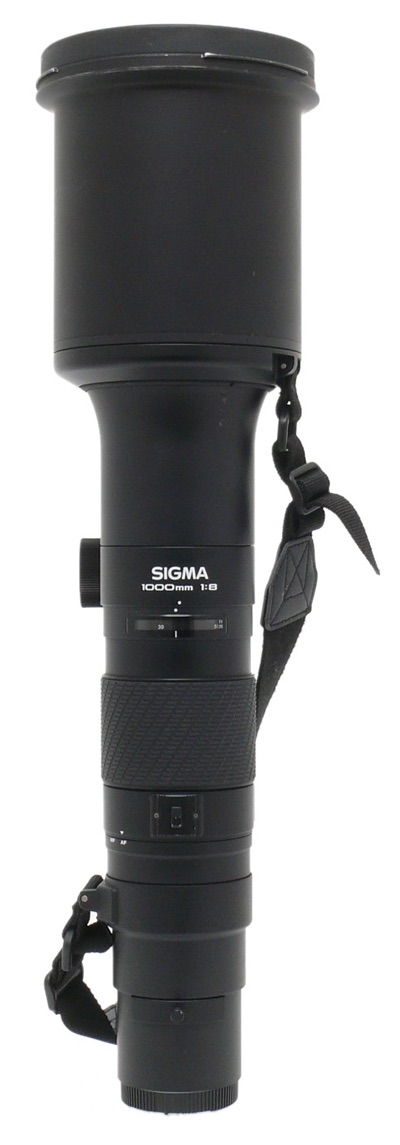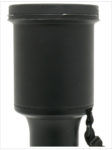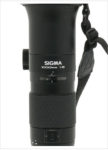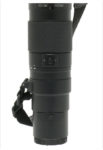Sigma 1000mm F/8 APO ZEN
Super telephoto prime lens • Film era • Discontinued
Abbreviations
| APO | Apochromatic optical design. |
Specification
| Optical design: | |
| 35mm full frame | |
| 1000mm | |
| F/8 | |
| 11 elements in 10 groups | |
| 2 SLD | |
| Internal focusing (IF) | |
| Canon EF [44mm] | |
| Minolta/Sony A [44.5mm] | |
| Nikon F [46.5mm] | |
| Sigma SA [44mm] | |
| 2.5° (35mm full frame) | |
| On Canon EOS APS-C [1.59x] cameras: | |
35mm equivalent focal length: | 1590mm (in terms of field of view) |
35mm equivalent speed: | F/12.7 (in terms of depth of field) |
Diagonal angle of view: | 1.6° |
| On Sony DSLR-A/SLT-A APS-C [1.53x] cameras: | |
35mm equivalent focal length: | 1530mm (in terms of field of view) |
35mm equivalent speed: | F/12.2 (in terms of depth of field) |
Diagonal angle of view: | 1.6° |
| On Nikon D APS-C [1.53x] cameras: | |
35mm equivalent focal length: | 1530mm (in terms of field of view) |
35mm equivalent speed: | F/12.2 (in terms of depth of field) |
Diagonal angle of view: | 1.6° |
| On Sigma SD APS-C [1.74x] cameras: | |
35mm equivalent focal length: | 1740mm (in terms of field of view) |
35mm equivalent speed: | F/13.9 (in terms of depth of field) |
Diagonal angle of view: | 1.4° |
| Diaphragm mechanism: | |
Diaphragm type: | Automatic |
Aperture control: | None; the aperture is controlled from the camera (Canon EF, Minolta/Sony A, Sigma SA) |
| Aperture ring (Manual settings + Auto Exposure setting) (Nikon F) | |
| <No data> | |
| Focusing: | |
| 15m | |
| 1:15 | |
Focusing modes: | Autofocus (AF), Manual focus (M) |
Autofocus motor: | Micromotor (Canon EF, Sigma SA) |
| In-camera motor (Nikon F, Minolta/Sony A) | |
Manual focus control: | Focusing ring |
Focus mode selector: | AF - M (Canon EF, Sigma SA) |
| None; focusing mode is set from the camera (Nikon F, Minolta/Sony A) | |
Manual focus override in autofocus mode: | - |
| Optical Stabilizer (OS): | |
| - | |
| Physical characteristics: | |
| 5240g (Nikon F) | |
| ⌀154×549.7mm (Nikon F) | |
| Accessories: | |
| Screw-type 137mm | |
Additional features: | Drop-in filter holder (34mm) |
| <No data> | |
| Sigma APO Tele Converter 1.4X EX → 1400mm F/11.2 | |
| Sigma APO Tele Converter 1.4X EX DG → 1400mm F/11.2 | |
| Sigma APO Tele Converter 2X EX → 2000mm F/16 | |
| Sigma APO Tele Converter 2X EX DG → 2000mm F/16 |
Source of data
- Manufacturer's technical data.
Manufacturer description
The Sigma APO 1000mm F8 ZEN is the world's first autofocus 1000mm super telephoto lens and the smallest in its class. It lets you fully enjoy the world of super telephoto photography including shooting closeups of distant panoramas, and delivers startling "compressed" perspective effects as well. Its internal focusing system enables you to respond quickly to your subject to shoot newspaper type action photos: outdoor sports, and wildlife. Chromatic aberration, which is characteristic of a super telephoto lens, has been reduced to a minimum by using special optical design and two pieces of SLD (Special Low Dispersion) glass for the front elements. This provides sharp, clear images at every aperture. The exclusive "ZEN" matte finish provides a sure grip, prevents reflections and resists scratches.
From the editor
One of Sigma's classic lenses, and rarely seen, the 1000mm F8 APO. It was announced at Photokina 1988 but then re-announced in February 1989, before a 1992 press release which seems to give different specifications but an otherwise identical description.
Notes
- The autofocus will not be available with Nikon D40, D40X, D60, D3000-D3500, D5000-D5600 digital SLR cameras.
- Sigma had to reverse engineer the communication protocol of the Canon EF mount to produce a version of this lens for Canon EOS 35mm film SLR cameras. As a consequence, this lens may not work properly with Canon EOS cameras (both film and digital) due to compatibility issues.
Frequently asked questions
What does the Sigma lens designation "ZEN" mean?
It means that the lens has a ZEN finish. ZEN is an acronym for Zeitgeist ("the spirit of the times"), Enhancement, and Nonglare. This nonreflective urethane resin finish was introduced around 1989 and replaced the old-style, painted satin-black finish. Sigma claimed it to be hard, strong, antichemical, nonslip, antiglare, and scratch-resistant, however, it actually had a tendency to peel off and become sticky as it aged.









